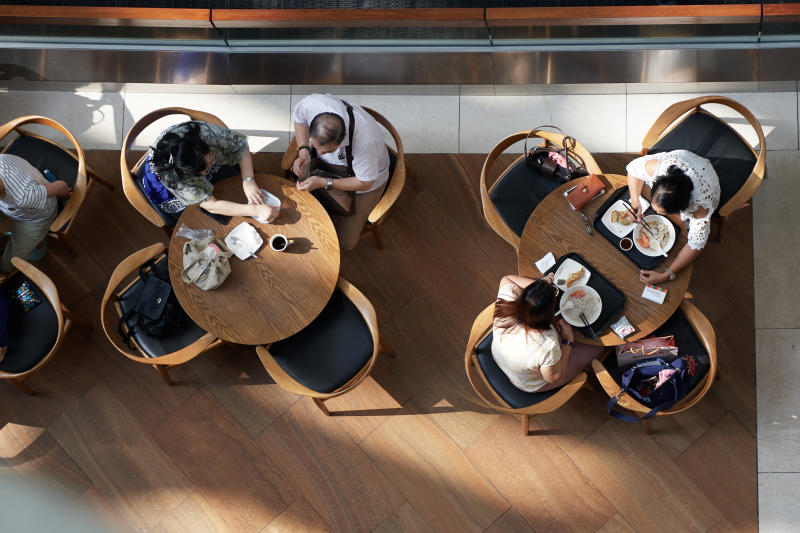Household incomes, living standards have gone up in five years: Govt survey
Sign up now: Get ST's newsletters delivered to your inbox

Food serving services as a portion of food expenditure grew to 68 per cent from 64 per cent previously.
PHOTO: ST FILE
Rachel Au-Yong, Rei Kurohi
Follow topic:
SINGAPORE - Families from all income groups are earning more compared to five years ago, and mostly at a higher rate than what they are spending, a government survey has found.
On top of this, the survey found the standard of living has continued to rise.
Conducted every five years, the latest Household Expenditure Survey is based on data collected in 2017 and 2018 for Singaporean and permanent resident households.
Overall, the average monthly household income rose to $11,780 from $10,470 in the previous survey conducted between 2012 and 2013. This works out to an average annual increase of 2.4 per cent a year in dollar terms. If inflation is taken into account, the rise is 2.2 per cent a year.
Spending on goods and services also went up to $4,910 a month from $4,720 five years before, a growth of 0.8 per cent a year.
For households in the top 20 per cent income group, their monthly expenditure remained relatively stable in the five-year period while income grew 1.6 per cent a year.
For the other groups, their incomes rose by 2.7 per cent to 3.3 per cent while expenditure swelled by 0.4 to 3 per cent a year.
Those in the bottom 20 per cent income group were the only ones whose annual expenses exceeded their income: their expenditure grew by 3 per cent while income grew by 2.8 per cent. Among these households, 36.7 per cent were headed by people aged 65 and older.
For housing types, the biggest income expansion was among households living in one-room and two-room Housing Board flats. The yearly increase, on average, was 6.3 per cent.
People spend more on eating out
The average monthly expenditure remained generally stable for families living in four-room Housing Board flats, condominiums and other apartments, and landed properties.
Those living in one-room, two-room, three-room and five-room flats, as well as executive flats, saw their expenditure increase by 0.8 to 3.7 per cent a year.
Housing, food and transport collectively made up the biggest portion or 62 per cent of monthly household expenditure, down slightly from the 65 per cent in the previous survey.
Food serving services as a portion of food expenditure grew to 68 per cent from 64 per cent previously. Households spent an average of $810 a month on such services compared with $760 previously.
The increase was mainly due to higher spending on restaurants, cafes and pubs, although hawker centres and foodcourts continued to make up the largest share of expenditure on these services.
Transport expenditure fell to $780 a month from $810 previously, mainly due to a drop in spending on private road transport like personal cars. Spending on bus and train fares also fell, while spending on taxis and private hire cars rose.
The proportion of households spending on online purchases also doubled, with about 60 per cent of households doing so compared with just 31 per cent five years before. Online expenditure as a portion of total expenditure rose from 1.7 per cent previously to 5 per cent in the latest survey.
Home ownership, standard of living rising
The survey also looked at home ownership rates and common household appliances as an indicator of the standard of living.
Home ownership remained high, at 89 per cent. Even for those in the bottom 20 per cent, 85 per cent owned their homes, up from 82 per cent five years ago.
Ownership of household appliances like televisions, washing machines and mobile phones was near universal - between 96 and 98 per cent - among all income groups.
At the same time, households in the lowest 20 per cent for income saw significant increases in their ownership of air-conditioners, as well as their access to Internet.
For example, a quarter of those living in one- and two-room HDB flats had air-conditioners, up from the 14 per cent in 2012/13.
And 45 per cent had an Internet subscription in 2017/18, double the 22 per cent five years ago.
Decline in digital cameras, pay TV and cars
Singapore Management University sociologist Paulin Straughan said the increase reflects the transformation in the physical landscape, and have become so necessary as to be considered "basic goods".
"On the one hand, air-conditioning is not as expensive as it used to be, and with climate change, it is arguably also necessary," she said. "Same with the Internet - if you cut someone off from the Internet, you leave them unable to bank easily or get information."
"There's no good or bad to the change, it is simply an evolution of our times."
Other items seem to have fallen out of favour, such as the telephone land line, digital cameras and pay TV, regardless of income groups and housing types - a trend Singstat attributes to the availability of substitutes such as mobile phones and online video streaming platforms.
Car ownership also declined, likely because of the increased availability of transport alternatives.

